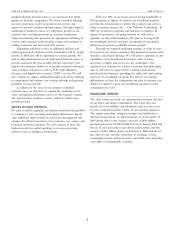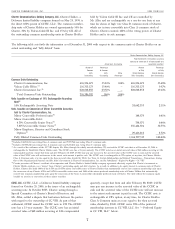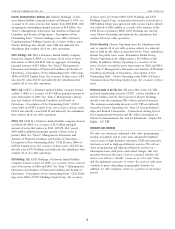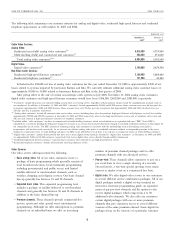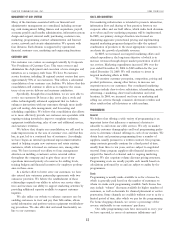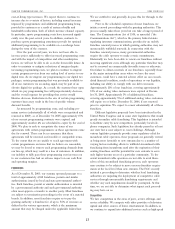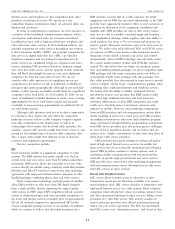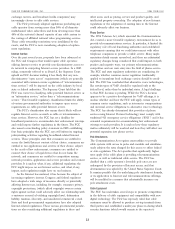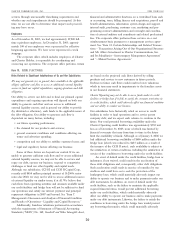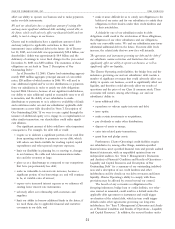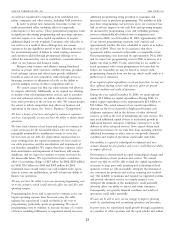Charter 2005 Annual Report Download - page 23
Download and view the complete annual report
Please find page 23 of the 2005 Charter annual report below. You can navigate through the pages in the report by either clicking on the pages listed below, or by using the keyword search tool below to find specific information within the annual report.
CHARTER COMMUNICATIONS, INC. 2005 FORM 10-K
cost-of-living type increases. We expect them to continue to We are entitled to and generally do pass this fee through to the
increase due to a variety of factors, including annual increases customer.
imposed by programmers and additional programming being Prior to the scheduled expiration of most franchises, we
provided to customers as a result of system rebuilds and initiate renewal proceedings with the granting authorities. This
bandwidth reallocation, both of which increase channel capacity. process usually takes three years but can take a longer period of
In particular, sports programming costs have increased signifi- time. The Communications Act of 1934, as amended (‘‘the
cantly over the past several years. In addition, contracts to Communications Act’’), which is the primary federal statute
purchase sports programming sometimes provide for optional regulating interstate communications, provides for an orderly
additional programming to be available on a surcharge basis franchise renewal process in which granting authorities may not
during the term of the contract. unreasonably withhold renewals. In connection with the
Over the past several years, we have not been able to franchise renewal process, many governmental authorities
increase prices sufficiently to offset increased programming costs require the cable operator to make certain commitments.
and with the impact of competition and other marketplace Historically we have been able to renew our franchises without
factors, we will not be able to do so in the foreseeable future. In incurring significant costs, although any particular franchise may
order to maintain or mitigate reductions of margins despite not be renewed on commercially favorable terms or otherwise.
increasing programming costs, we plan to continue to migrate Our failure to obtain renewals of our franchises, especially those
certain program services from our analog level of service to our in the major metropolitan areas where we have the most
digital tiers. As we migrate our programming to our digital tier customers, could have a material adverse effect on our consoli-
packages, certain programming that was previously available to dated financial condition, results of operations or our liquidity,
all of our customers via an analog signal, may be part of an including our ability to comply with our debt covenants.
elective digital tier package. As a result, the customer base upon Approximately 11% of our franchises, covering approximately
which we pay programming fees will proportionately decrease, 13% of our analog video customers were expired at Decem-
and the overall expense for providing that service would ber 31, 2005. Approximately 7% of additional franchises,
likewise decrease. Reductions in the size of certain programming covering approximately 9% of additional analog video customers
customer bases may result in the loss of specific volume will expire on or before December 31, 2006, if not renewed
discount benefits. prior to expiration. We expect to renew substantially all of these
As measured by programming costs, and excluding pre- franchises.
mium services (substantially all of which were renegotiated and Different legislative proposals have been introduced in the
renewed in 2003), as of December 31, 2005 approximately 15% United States Congress and in some state legislatures that would
of our current programming contracts were expired, and greatly streamline cable franchising. This legislation is intended
approximately another 4% are scheduled to expire by the end of to facilitate entry by new competitors, particularly local tele-
2006. We plan to seek to renegotiate the terms of our phone companies. Such legislation has already passed in at least
agreements with certain programmers as these agreements come one state but is now subject to court challenge. Although
due for renewal. There can be no assurance that these various legislative proposals provide some regulatory relief for
agreements will be renewed on favorable or comparable terms. incumbent cable operators, these proposals are generally viewed
To the extent that we are unable to reach agreement with as being more favorable to new entrants due to a number of
certain programmers on terms that we believe are reasonable, varying factors including efforts to withhold streamlined cable
we may be forced to remove such programming channels from franchising from incumbents until after the expiration of their
our line-up, which may result in a loss of customers. In addition, existing franchises and the potential for new entrants to serve
our inability to fully pass these programming cost increases on only higher-income areas of a particular community. To the
to our customers has had an adverse impact on our cash flow extent incumbent cable operators are not able to avail them-
and operating margins. selves of this streamlined franchising process, such operators
may continue to be subject to more onerous franchise require-
FRANCHISES ments at the local level than new entrants. The FCC recently
initiated a proceeding to determine whether local franchising
As of December 31, 2005, our systems operated pursuant to a authorities are impeding the deployment of competitive cable
total of approximately 4,100 franchises, permits and similar services through unreasonable franchising requirements and
authorizations issued by local and state governmental authori- whether any such impediments should be preempted. At this
ties. Each franchise, permit or similar authorization is awarded time, we are not able to determine what impact such proceed-
by a governmental authority and such governmental authority ing may have on us.
often must approve a transfer to another party. Most franchises
are subject to termination proceedings in the event of a material Competition
breach. In addition, most franchises require us to pay the We face competition in the areas of price, service offerings, and
granting authority a franchise fee of up to 5.0% of revenues as service reliability. We compete with other providers of television
defined in the various agreements, which is the maximum signals and other sources of home entertainment. In addition, as
amount that may be charged under the applicable federal law. we continue to expand into additional services such as high-speed
13


